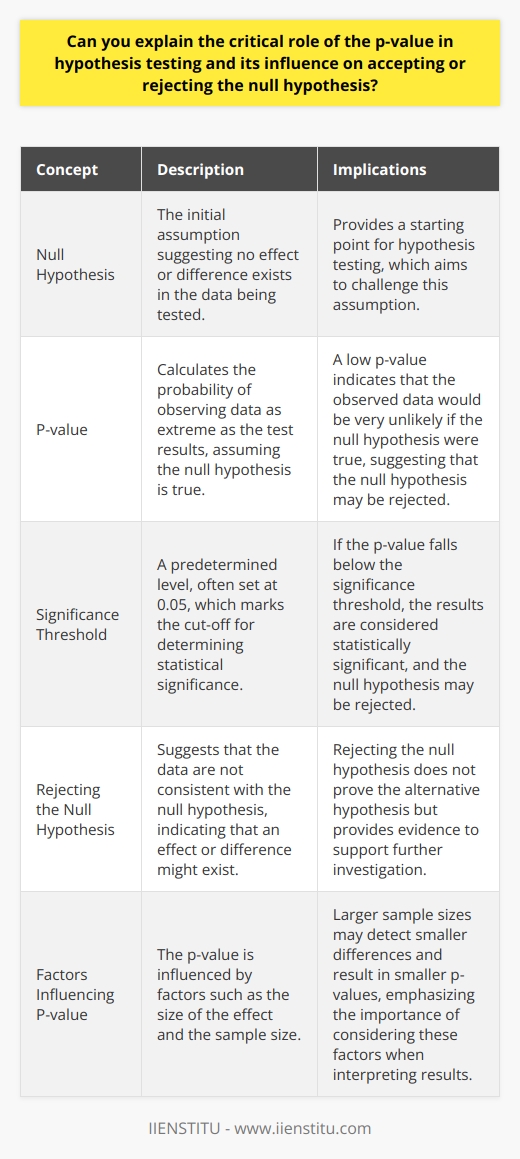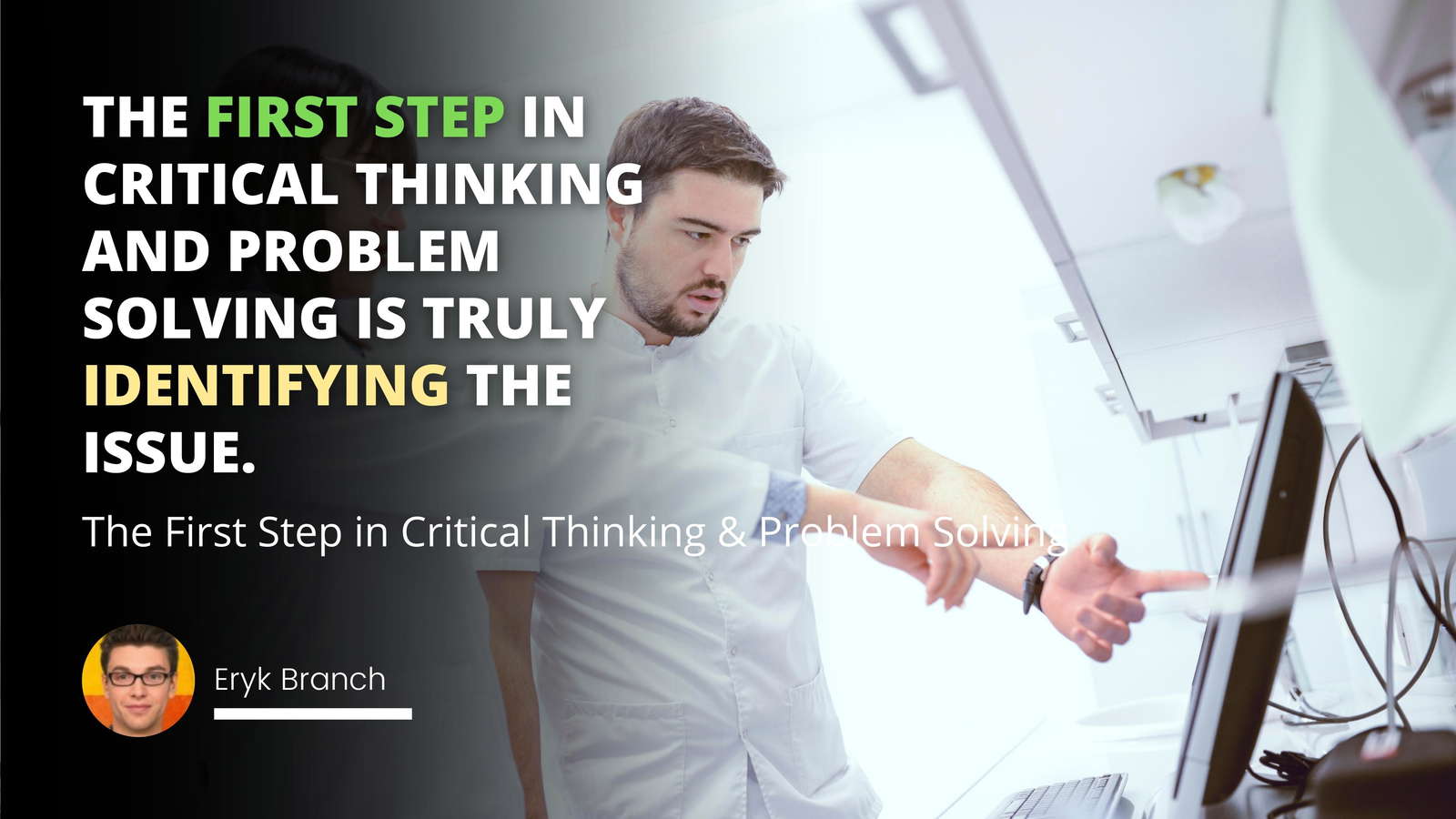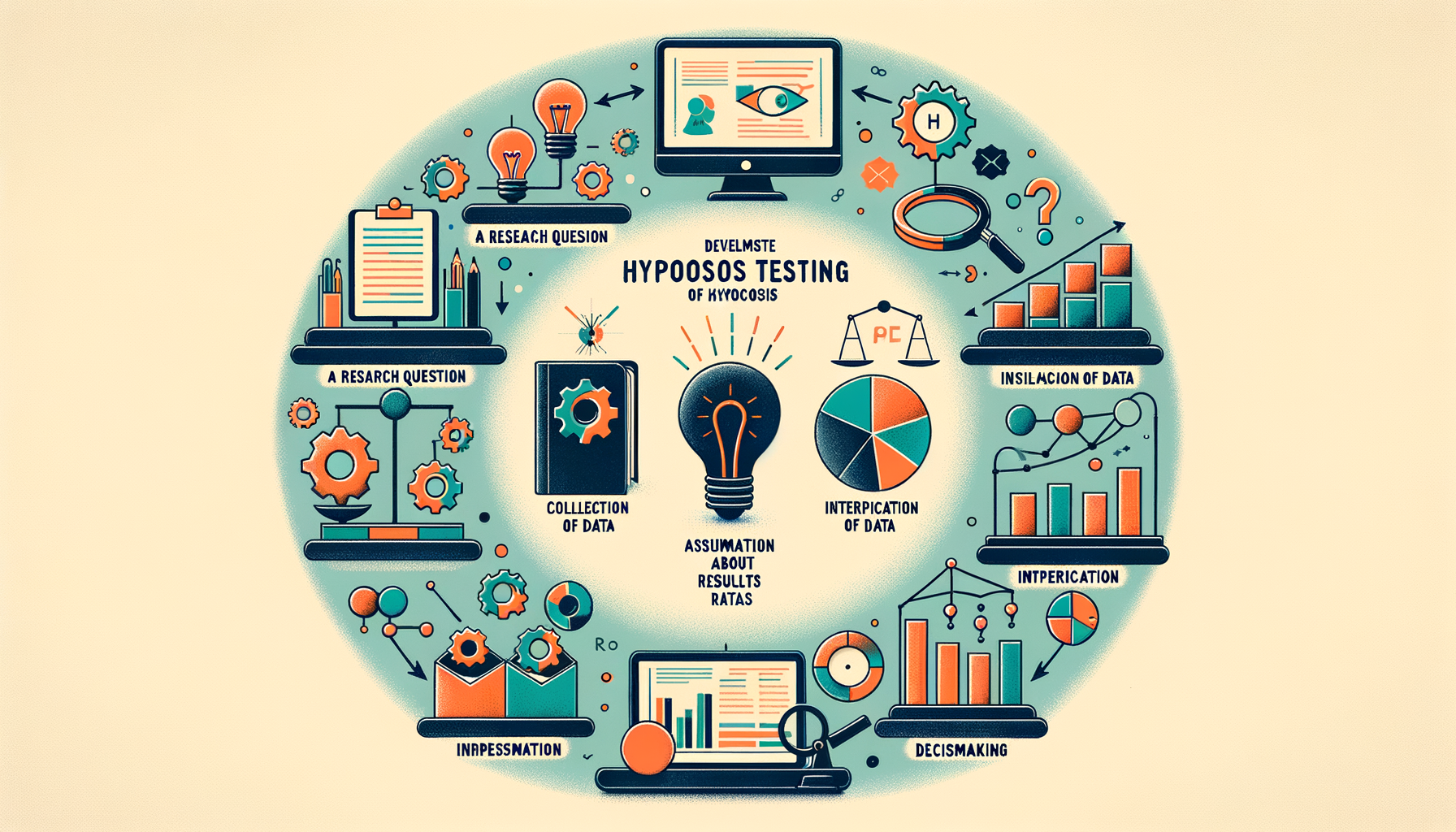
In scientific research and experimentation, one needs a structured framework for answering questions, confirming results, and making decisions.
This framework, known as hypothesis testing, plays a pivotal role both in research and in various industries like healthcare, finance, and technology.
This guide will delve into the principles and processes of hypothesis testing, offering readers a holistic understanding of this fundamental aspect of scientific decision-making.
Definition of Hypothesis Testing
Hypothesis testing is a method used in statistics to decide whether a statement about a population parameter is likely to be true based on sample data.
The process involves making an initial assumption, observing data, then determining how compatible the data is with the assumption. It's a core part of many online certificate programs and widely used in fields requiring data analysis.
Importance of Hypothesis Testing in Research and Industry
The value of hypothesis testing goes beyond science and research. Businesses use it for making crucial decisions, such as whether a new product will succeed in the market, or if a change in strategy will lead to increased profit margins.
Similarly, in the healthcare sector, hypothesis testing helps determine if a new medication is more effective than the current standard treatment. This broad applicability underlies the significance of a problem-solving course that includes hypothesis testing.
Understanding the Basics of Hypothesis Testing
Before embarking on the journey of hypothesis testing, it's crucial to understand its fundamental elements - the Null and Alternate Hypotheses.
Explanation of Null Hypothesis
Definition Null Hypothesis
The Null Hypothesis, symbolized as H0, is a statement we test for possible rejection under the assumption that it is true. In most cases, it anticipates no effect, no difference, or no relationship between variables.
How to Formulate a Null Hypothesis
Formulating a null hypothesis requires identifying your research question, specifying your outcome variable, and expressing a statement of no effect or difference. For instance, you may hypothesize, "There is no significant difference between the performance of students who have breakfast and those who don't."
Practical Examples of Null Hypotheses
Consider a beverage company aiming to reduce its plastic use by 20% within a year. The null hypothesis might state that "There has been no decrease in the company's plastic use."
Explanation of Alternate Hypothesis
Definition Alternate Hypothesis
The alternative hypothesis, symbolized as H1, is the statement we accept when there's sufficient evidence against the null hypothesis. It anticipates an effect, a difference, or a relationship between variables.
How to Construct an Alternate Hypothesis
In constructing an alternate hypothesis, we simply state the counter of the null hypothesis. Following the above example, the alternate hypothesis would be, "There's a significant difference between the performance of students who have breakfast and those who don't."
Case Examples of Alternate Hypotheses
Referring to the beverage company example, the alternate hypothesis would state, "There has been a decrease in the company's plastic use."
Differentiating between Null and Alternate Hypotheses
While both form the crux of hypothesis testing, their roles differ significantly. The null hypothesis is the claim we test for possible rejection, while the alternate hypothesis is accepted when there's evidence against the null. However, neither proof nor disproof of either hypothesis is definitive since all statistical tests are susceptible to errors.
Understanding Errors in Hypothesis Testing
A critical aspect of hypothesis testing is the recognition and management of two types of errors: Type I and Type II errors. Understanding these errors is paramount for interpreting the results accurately and making informed decisions.
Type I Error: False Positive
A Type I error occurs when the null hypothesis is wrongly rejected when it is actually true. This is akin to a false alarm, where, for instance, a test indicates a drug is effective against a disease when it actually isn't. The probability of committing a Type I error is denoted by alpha (α), often set at 0.05 or 5%, indicating a 5% risk of rejecting the null hypothesis incorrectly.
Type II Error: False Negative
Conversely, a Type II error happens when the null hypothesis is not rejected when it is false. This can be compared to a missed detection, such as failing to identify the effectiveness of a beneficial drug. The probability of a Type II error is denoted by beta (β), and researchers strive to minimize this risk to ensure that genuine effects are detected.
Balancing the Risks: Power of the Test
The power of a statistical test is the probability that it correctly rejects a false null hypothesis, essentially avoiding a Type II error. High-powered tests are more reliable for detecting true effects. The power is influenced by the sample size, effect size, significance level, and variability within the data. Optimizing these factors can reduce the chances of both Type I and Type II errors, leading to more trustworthy conclusions.
Steps in Hypothesis Testing
Hypothesis testing involves a series of structured steps to guide researchers and professionals through the decision-making process:
Formulate Hypotheses: Clearly define the null and alternative hypotheses based on the research question or problem statement.
Choose a Significance Level (α): Decide on the alpha level, which determines the threshold for rejecting the null hypothesis.
Select the Appropriate Test: Based on the data type and study design, choose a statistical test that aligns with the research objectives.
Collect and Analyze Data: Gather the necessary data and perform the statistical test to calculate the test statistic and p-value.
Make a Decision: Compare the p-value to the significance level. If the p-value is less than α, reject the null hypothesis in favor of the alternative. Otherwise, do not reject the null hypothesis.
Hypothesis testing is a cornerstone of scientific inquiry, providing a rigorous framework for evaluating theories, exploring relationships, and making decisions based on empirical evidence.
Whether in academia, healthcare, finance, or technology, the principles of hypothesis testing enable practitioners to draw conclusions with a defined level of confidence, navigate uncertainties, and contribute to advancements in their fields. By understanding its fundamentals, errors, and steps, professionals can apply hypothesis testing to enhance decision-making processes and achieve more reliable outcomes.
Through this exploration of hypothesis testing, it becomes clear that the method is not just a statistical tool but a comprehensive approach to answering complex questions across various domains. As researchers and industry professionals continue to harness its power, the potential for innovation and discovery remains boundless.
Frequently Asked Questions
What is the fundamental concept and importance of hypothesis testing in scientific decision-making?
Understanding Hypothesis Testing
Hypothesis testing is a cornerstone of scientific inquiry. It involves making an assumption, the hypothesis, about a population parameter. Scientists test these assumptions through experimentation and observation.
The Essence of Hypotheses
At its core, a hypothesis is a predictive statement. It usually pertains to an outcome or a relationship between variables. The hypothesis asserts a specific effect, direction, or magnitude will emerge under certain conditions.
Types of Hypotheses
There are two primary hypotheses in testing: null and alternative. The null hypothesis (H0) suggests no effect or relationship exists. It represents a default position, waiting for evidence to challenge it. The alternative hypothesis (H1) posits there is an effect or relationship. It states the specific condition the researcher believes is true.
Role of Evidence
Evidence plays a critical role. Researchers collect data through controlled methods. They aim to either support or refute the hypothesis. This data must be empirical and measurable, ensuring objectivity.
Decision-Making with P-Values
The p-value is a crucial concept in hypothesis testing. It is the probability of observing a test statistic as extreme as the one observed, given the null hypothesis is true. A low p-value indicates the observed data is unlikely under the null hypothesis. This typically leads to rejection of the null in favor of the alternative.
The Importance of Hypothesis Testing
Provides structure to research
Ensures consistency in methods
Allows quantification of evidence
Facilitates replication of studies
Shields from personal biases
Hypothesis testing helps map the unknown territory of scientific phenomena. It allows researchers to make informed decisions grounded in statistical evidence. This rational approach to understanding ensures that conclusions drawn from scientific work are reliable and valid.
The process also shapes the scientific method itself. It demands rigorous standards for evidence and reproducibility. Hypothesis testing thus builds a foundation on which scientific knowledge advances. It underpins the integrity of scientific disciplines. It challenges scientists to prove, disprove, and refine their understanding of the world.
Hypothesis testing is fundamental to the scientific decision-making process. It turns subjective questions into objective inquiries. It drives the pursuit of knowledge through empirical evidence. With hypothesis testing, science moves from conjecture to proven or disproven theories. It is this disciplined approach that adds credibility to scientific findings. Without it, distinguishing between chance results and true discoveries becomes impossible.
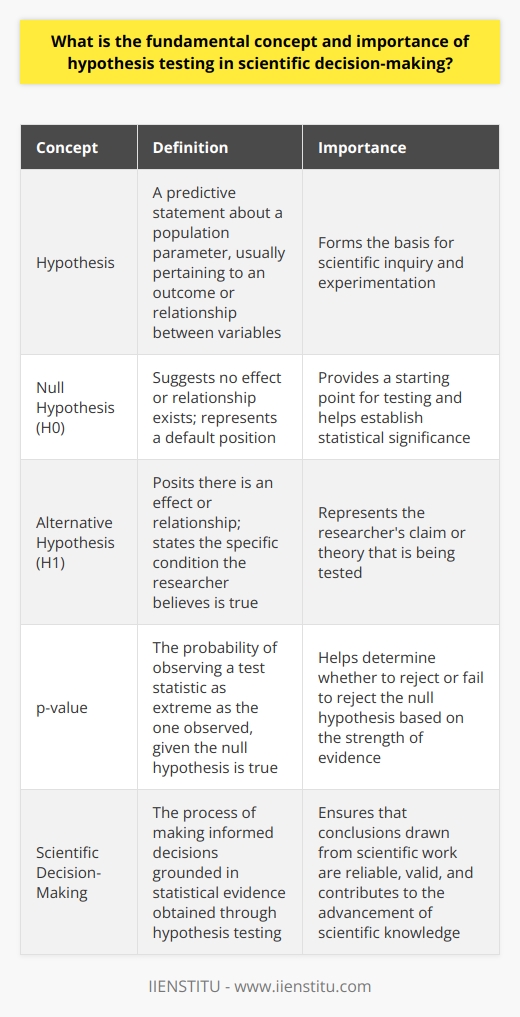
How do Type I and Type II errors relate to hypothesis testing and what are their implications on the results?
Understanding Type I and Type II Errors
When delving into hypothesis testing, the concepts of Type I and Type II errors often emerge as critical elements. These errors play a paramount role in the interpretation of results. They convey the instances where our conclusions could be incorrect.
What Are Type I and Type II Errors?
Type I error occurs when we wrongly reject a true null hypothesis. We call this a false positive. It implies that the evidence suggests an effect or difference exists when it does not. In statistical terms, this is the 'alpha' (α), which defines the likelihood of a Type I error.
Type II error, in contrast, happens when we fail to reject a false null hypothesis. This error, termed a false negative, means that one overlooks an actual effect or difference. It's quantified by 'beta' (β), which gives the probability of a Type II error occurring.
Implications of Type I and Type II Errors
The implications of these errors reach far into hypothesis testing and the trustworthiness of results.
Confidence Levels: High risks of Type I errors lower confidence in findings. To mitigate this, researchers set a low alpha level, commonly 0.05. It shows a willingness to accept a 5% chance of a false positive.
Power of the Test: The risk of Type II errors correlates with the power of the test—the probability of correctly detecting an effect when it exists. A high beta value means a higher chance of missing an actual effect due to low test power.
Sample Size: Larger samples reduce both Type I and Type II error risks. They offer more accurate estimates and a clearer distinction between the null and alternative hypotheses.
Consequences: Type I errors might lead to unwarranted actions based on false positives. Type II errors could result in missed opportunities due to unrecognized truths.
Balancing Errors in Hypothesis Testing
Researchers must balance Type I and Type II errors in hypothesis testing. The balance depends on the context and potential consequences of each error.
Safety in Medicine: In drug testing, Type I errors can lead to harmful side effects if a drug isn't actually safe. Minimizing Type I errors is crucial here.
Effectiveness in Treatment: Conversely, Type II errors in medicine may miss a treatment effect. Ensuring sufficient power to detect treatment efficacy is essential.
Type I and Type II errors remind us of the limitations in hypothesis testing. No test is infallible. Decisions on alpha and beta levels depend on the stakes of potential errors.
Understanding and addressing these errors are vital. They enhance credibility in conclusions drawn from statistical testing. Proper balance ensures valuable and trustworthy research outcomes.
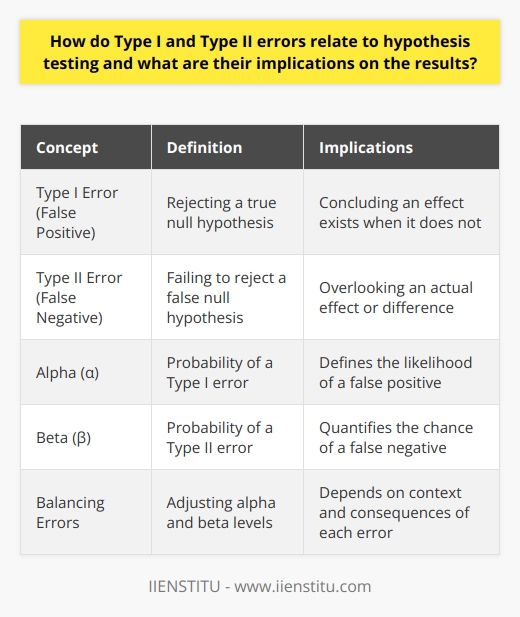
Can you explain the critical role of the p-value in hypothesis testing and its influence on accepting or rejecting the null hypothesis?
Understanding the P-value
Researchers often turn to hypothesis testing to understand data. They make an initial assumption called the null hypothesis. This hypothesis suggests no effect or no difference exists. To challenge this, they use an alternative hypothesis.
The Null Hypothesis and P-value
In hypothesis testing, the p-value helps measure the strength of the results against the null hypothesis. It calculates the probability of observing data as extreme as the test results, assuming the null hypothesis is true. A low p-value indicates that the observed data would be very unlikely if the null hypothesis were true.
Significance Threshold
Scientists usually set a significance level before testing. Often, this level is 0.05. It marks the cut-off for determining statistical significance.
If the p-value is below 0.05, the result is statistically significant.
This means the test provides enough evidence to reject the null hypothesis.
What Does Rejecting the Null Hypothesis Mean?
Rejecting the null does not prove the alternative hypothesis. It merely suggests that the data are not consistent with the null. Researchers can be more confident that an effect or difference might exist.
Misinterpretations of the P-value
A common mistake is seeing the p-value as the odds that the null hypothesis is true or false. It is not. It only assesses how compatible the data are with the null hypothesis.
Influencing Factors
Several factors influence the p-value. This includes the size of the effect and the sample size. Larger samples may detect smaller differences and result in smaller p-values.
The p-value is critical in deciding whether to accept or reject the null hypothesis. It quantifies how surprising the data are, assuming the null is true. A small p-value can lead to rejecting the null, paving the way for new scientific insights. However, it is crucial to use this tool wisely, with an understanding of its limitations and context.
